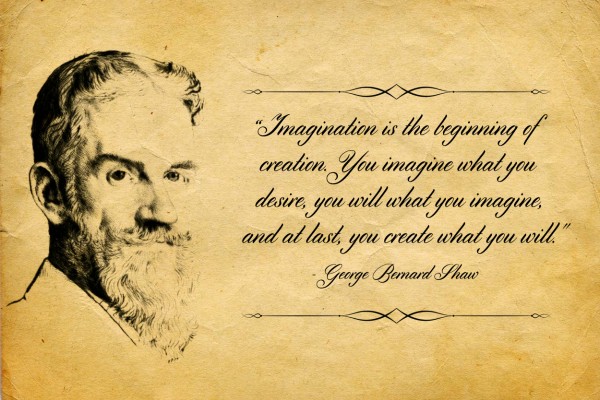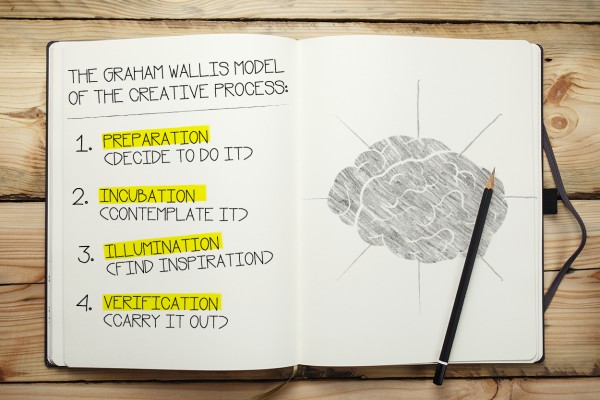As a presentation design firm with a pretty unique specialty, we often have to find inspiration within the narrow confines of a presentation assignment. Our content, design, and marketing team all occasionally play a game of pacing and praying for the Muse to strike. If you’re fishing for some presentation or speech inspiration in the ocean of resources we have, you may also be looking for a creative boost.
Where does this inspiration come from? And how can you actively seek a more “creative” state of mind when all you’ve done the past few hours is wish someone a happy birthday on Facebook?
How it Works
You might already have a vague idea of how creativity in the brain happens: the left side of the brain works hard on facts and figures, while the right side is busy cooking up masterpieces and piano sonatas. However, cognitive neuroscientists have recently discovered that creativity doesn’t lie within merely the right side of the brain: the real process is much more complex.
“The entire creative process– from preparation to incubation to illumination to verification– consists of many interacting cognitive processes (both conscious and unconscious) and emotions. Depending on the stage of the creative process, and what you’re actually attempting to create, different brain regions are recruited to handle the task.” – Source article, “The Neuroscience of Creativity.”
What the article describes as the “creative process” is referring to researcher Graham Wallis’ model of the creative process, which is composed of four different steps:
1. Preparation – This is the moment when we acknowledge the problem we need to solve creatively, and begin to conceptualize what will be done to get there. This is sort of like the moment when a homework assignment is written on the whiteboard, ready to haunt your weekend.
2. Incubation – Incubation describes the process of mentally planning how to tackle your project. This contemplation period can be a slow-going process, from days to years.
3. Illumination – Illumination is the moment when all of the pacing and worrying and planning comes to fruition: the moment of insight (or Muse) finally strikes, and you are able to creatively see the solution. In short, you’re ready to grab a paintbrush and make a beautiful mural across the whole city.
4. Verification – This final stage is all about carrying out your actions and ensuring that it meets all of the checks which were established in Preparation.
Rather than thinking of your brain working in “sides” to accomplish these four sequential tasks, picture the brain as different interconnected networks that become active depending on the task at hand. For instance, did you know that you have an Imagination Network within the brain?
“According to Randy Buckner and colleagues, the Default Network (referred to here as the Imagination Network) is involved in “constructing dynamic mental simulations based on personal past experiences such as used during remembering, thinking about the future, and generally when imagining alternative perspectives and scenarios to the present.” The Imagination Network is also involved in social cognition. For instance, when we are imagining what someone else is thinking, this brain network is active.” -Source article, “The Neuroscience of Creativity.”
How can we tune into our Imagination Network and kickstart our creative process if we are stuck in the incubation stage with no end in sight?
How to Harness it
Since the creative process is dictated by our brain’s ability to problem solve, finding your Muse doesn’t have to mean sitting around and waiting for that “lightning moment.” Tie a key to that kite and run dangerously into a creative storm with these ideas:
Turn Off the Lights – It sounds crazy, but research suggest that a dim lighting environment can enhance creativity. A research article published in the Journal of Environmental Psychology examined people’s creative ability in environments in locations with different levels of brightness. They found that dim lighting aided creativity by reducing inhibitions and encouraging risk-taking.
“Two additional studies tested the underlying mechanism and showed that darkness elicits a feeling of being free from constraints and triggers a risky, explorative processing style. As expected, perceived freedom from constraints mediated the effect of dim illumination on creativity.” (Source study)
Indulge in a Pick-Me Up – Neuroscientists have found that when dopamine is released in the brain, certain parts of the brain become more active and tuned-in to the creative process. Dopamine is released when we are happy, relaxed, and engaged in an activity that allows us to focus inwards instead of on external stimuli. This is why some of our best ideas happen in the shower. Exercising or a long drive can also be a way to naturally release dopamine.
As mentioned earlier in Wallis’ model of the creative process, these pick-me-ups have the power to enhance the incubation stage of creativity: “Especially if you have thought long and hard all day about a problem, jumping into the shower can turn into what scientist call the “incubation period” for your ideas. The subconscious mind has been working extremely hard to solve the problems you face and now that you let your mind wander, it can surface and plant those ideas into your conscious mind.” – Leo Widrich
Gain a Routine – Setting aside a time, location, and certain atmosphere for creative work can act as a signal to the brain that it’s time to get down to business. Aside from merely dimming the lights, you may consider other factors like creating ambient noise, setting a strict timer, and eliminating any social media distractions. From the complex to the downright silly, routines have been part of many great artist’s process, and for good reason. They provide a mental break from the distractions of our hectic day.
“The idea is that your creativity acts like a tortoise–poking its head out nervously to see if the environment is safe before it fully emerges. Thus, you need to create a tortoise enclosure–an oasis amongst the craziness of modern life–to be a safe haven where your creativity can emerge.” – John Cleese
Go to Bed – In the same way that dopamine gives our brain a “happy place” to freely wander, sleep can be used as a tool to help solve problems and come up with fresh ideas. Studies have shown that the period of time when we are coming out of sleep, also known as the hypnopompic state, can foster remote associations that form new ideas and creative concepts.
For instance, two groups of patients were given a memory test at Berkeley. The first set of information they received was delivered early in the day, and then they were tested for this information at different points of time later. They found that: “when it came to the harder inferences, people who had a night’s sleep between training and testing got a startling 93% correct, whereas those who’d been busy all day only got 70%.”
If you’re having a hard time solving a creative problem or finding inspiration, you may consider taking a short nap or revisiting the problem the next day to harness some of sleep’s brain-boosting power.
The Power of A Nice Walk – Talking a walk outdoors has anecdotally been a way that many people find inspiration and creative juice, but science has also been able to verify this notion. Researchers at Stanford led by Marily Oppezzo studied the effects of spending some time walking outdoors had on people with tasks at hand.
“The students who walked, whether indoors or outside, came up with more creative responses than those either sitting inside or being pushed in a wheelchair outdoors. While being outdoors has many cognitive benefits, walking appears to have a very specific benefit of improving creativity.” (Source article, Psychology Today)
Before you create a routine or dash outdoors to seek creative inspiration, ask yourself the following questions to customize your process:
When was the last time I was most creative?
How can I recreate my most productive environment?
Where could I place a regular creative routine?
Increasing the awareness of your environment may help your brain unlock new ideas and solve any creative problems it may be facing. Don’t wait for the Muse to strike: create an environment that the Muse would like to visit at. Bring out your best china and set out some cookies for the Muse, and you may receive a visit sooner than you expect.
Question: How can you make your environment more creativity-friendly?



